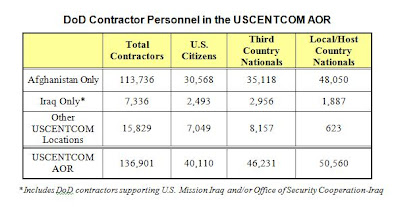What is the current number of US and Afghan forces currently deployed and funded?
The answer may surprise you.
The combined forces - paid for by the US - is 567,655.
The office of the Special Inspector General for Afghanistan Reconstruction (SIGAR) released their mandated quarterly report yesterday. With access to all official agencies involved with the war, it is one of the most authoritative reports available to the public.
The Special Inspector report is used to document the total number of US troops and Afghan National Security Forces. The figure for contractors comes from CENTCOM and the Office of the Deputy Assistant Secretary of Defense.
Here is the breakdown.
Afghanistan National Security Forces
191,592 – Afghan National Army (May 2012)
146,641 – Afghan National Police (June 2012)
Total – 338,233
US Military and Contractors
87,000 – Troops Deployed in Afghanistan (June 2012)
113,736 – Department of Defense (DoD) Contractors (July 2012)
28,686 – DoD Private Security – does not include USAID and State (July 2012)
Total – 229,422
Number of US Troops from SIGAR
Contractor numbers from CENTCOM Quarterly Contractor Census Report (DoD)
Afghan Security Forces from SIGAR
Two additional points from the special inspector report.
The goal is to build the Afghan National Security Forces (ANSF) to 352,000 and then reduce the force to 228,500 by 2017. The Government of Afghanistan is scheduled to contribute $500 million by 2015. That represents less than 10% of the cost.
“The United States is covering most of the costs of the ANA (and provides a substantial amount for the ANP. The NATO Summit joint communiqué stipulates that the Afghan government will contribute $500 million in 2015 toward the sustainment of its security forces and gradually increase its share of the ANSF costs until 2024, when it will have full financial responsibility for its security forces.”On July 6, 2012, President Obama signed the order making Afghanistan a Major Non-NATO Ally. That makes it eligible for U.S. training, loans of equipment for research and development, and foreign military financing.











